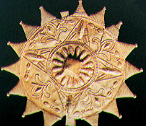Jan 25, 2016
Gold Mining and Jewelry of the Western Region
The Western Region is the largest producer of cocoa and timber, the second highest producer of gold, with the potential to become the highest producer of this commodity. There are five major gold mines, namely Teberebie and Iduaprem goldfields, both now owned by Ashanti goldfields, Prestea/Bogoso mines now owned by a South African company, Tarkwa goldfields, and Aboso goldfields located at Damang near Huni Valley. There are other proven but as yet unexploited ore deposits at Tarkwa, Aboso, Bondaye, and the forest reserve areas of Jomoro and Nzema East, Aowin-Suaman, Amenfi and Mpohor-Wassa-East districts.
Nzemas of the Western Region were noted as goldsmiths in the past. Because Nzemaland contains huge deposits of gold, a lot of Nzema men work as goldsmiths and women traditionally sell gold and jewelry. During the colonial period, the Nzema were known to supply other
kingdoms with bullets made by goldsmiths. Nzema women also sold the goldsmiths’ jewelry.
A goldsmith is a metalworker who specializes in working with gold and other precious metals. Historically, goldsmiths also have made silverware, platters, goblets, decorative and serviceable utensils, and ceremonial or religious items, but the rising prices of precious metals have curtailed the making of such items to a large degree.
Goldsmiths must be skilled in forming metal through filing, soldering, sawing, forging, casting, and polishing metal. Traditionally, these skills had been passed along through apprenticeships.
Gold could be found in several places in the auriferous Akan areas in Ghana and in spite of the unsophisticated technology in use at the time, indigenous miners had means of identifying where gold
could be found. Gold prospectors dug pits in places where nuggets had been washed out during the rains and therefore offered hope of recovery of sufficient quantities.
Click here to visit gallery

